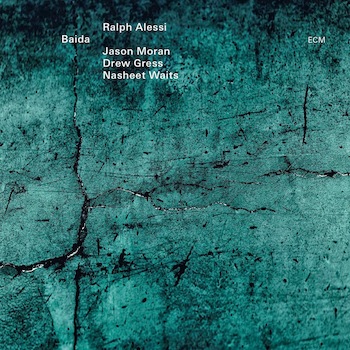Classical Music CD Review: Ralph Alessi’s “Baida” — Consistently Surprising
Baida, Ralph Alessi, (ECM 2321)
by Michael Ullman
Recently the New England Conservatory announced that trumpeter Ralph Alessi has joined its jazz faculty to teach trumpet and improvisation. It seemed inevitable that he would land up at NEC. His recent disc Only Many (CAM 5048) is made up of a series of duets with pianist and NEC faculty member Fred Hersch. And Alessi’s most recent album, Baida, is a quartet date with another celebrated NEC teacher, the pianist Jason Moran.
Alessi, who was born in San Francisco, took lessons from his trumpet-playing father, though he says that he was also influenced by the pop music he heard in California. He was also inspired by a teacher who taught Alessi via Clifford Brown sessions. He has degrees from CalArts in both trumpet and bass; he studied with bassist Charlie Haden. As a trumpeter he has played for a number of decades in dozens of challenging, postbop settings, including the bands of the influential saxophonist Steve Coleman, who taught him, among other things, a hands-off approach to band leading.
There’s something good-humored about even Alessi’s freest pieces. The third number on Baida (baida is what his two-year-old daughter calls her blanket) is “Gobble Goblins.” It begins with Alessi playing a long, humorously insistent series of staccato notes that jump about the first few notes of a scale. The circular insistence of this repetition is typical of Alessi’s creative use of odd intervals in readily identifiable shapes. Pianist Jason Moran joins and takes over this initial theme, while bassist Drew Gress and drummer Nasheet Waits offer counter examples. Over this rich, though still spare, background, Alessi takes a wide-ranging solo. I have no explanation for the title of the tune “Chuck Barris,” except to remind readers that Barris was a game show host who also fantasized in print that he was a CIA assassin. The odd rhythms and fascinating counterpoint between front line and rhythm section in this tune are not particularly suggestive of ’70s music, but the long improvisatory section demonstrates the band’s ability to make a quartet sound complex and yet, thanks to the underlying composition, orderly.
Alessi’s tunes, such as “Shank,” are usually on the move from the very first notes. His compositions are flexible rather than tightly organized, yet their initial statements, whether by Alessi alone or in duet with the bass, as in “Shank,” are strong enough to dominate even the freest group improvisations that follow. I am intrigued by his titles, as well as by the unexpected intervals and insistent shapes of his compositions: “Throwing Like a Girl” is a surprisingly sober tune introduced by bassist Gress. Waits’ martial drums, looming under the long tones and scalar passages of the muted trumpet, played here in unison with Moran, seem to defy the cocky nature of the boyhood insult.
The disc is full of surprises, yet Baida is marked by Alessi’s consistently strong compositional ideas and arrangements. This band has an undeviating vision: Baida seems to me to be a triumph of rock solid character.
Michael Ullman studied classical clarinet and was educated at Harvard, the University of Chicago, and the U. of Michigan, from which he received a PhD in English. The author or co-author of two books on jazz, he has written on jazz and classical music for The Atlantic Monthly, The New Republic, High Fidelity, Stereophile, The Boston Phoenix, The Boston Globe and other venues. His articles on Dickens, Joyce, Kipling, and others have appeared in academic journals. For over 20 years, he has written a bi-monthly jazz column for Fanfare Magazine, for which he also reviews classical music. At Tufts University, he teaches mostly modernist writers in the English Department and jazz and blues history in the Music Department. He plays piano badly.

